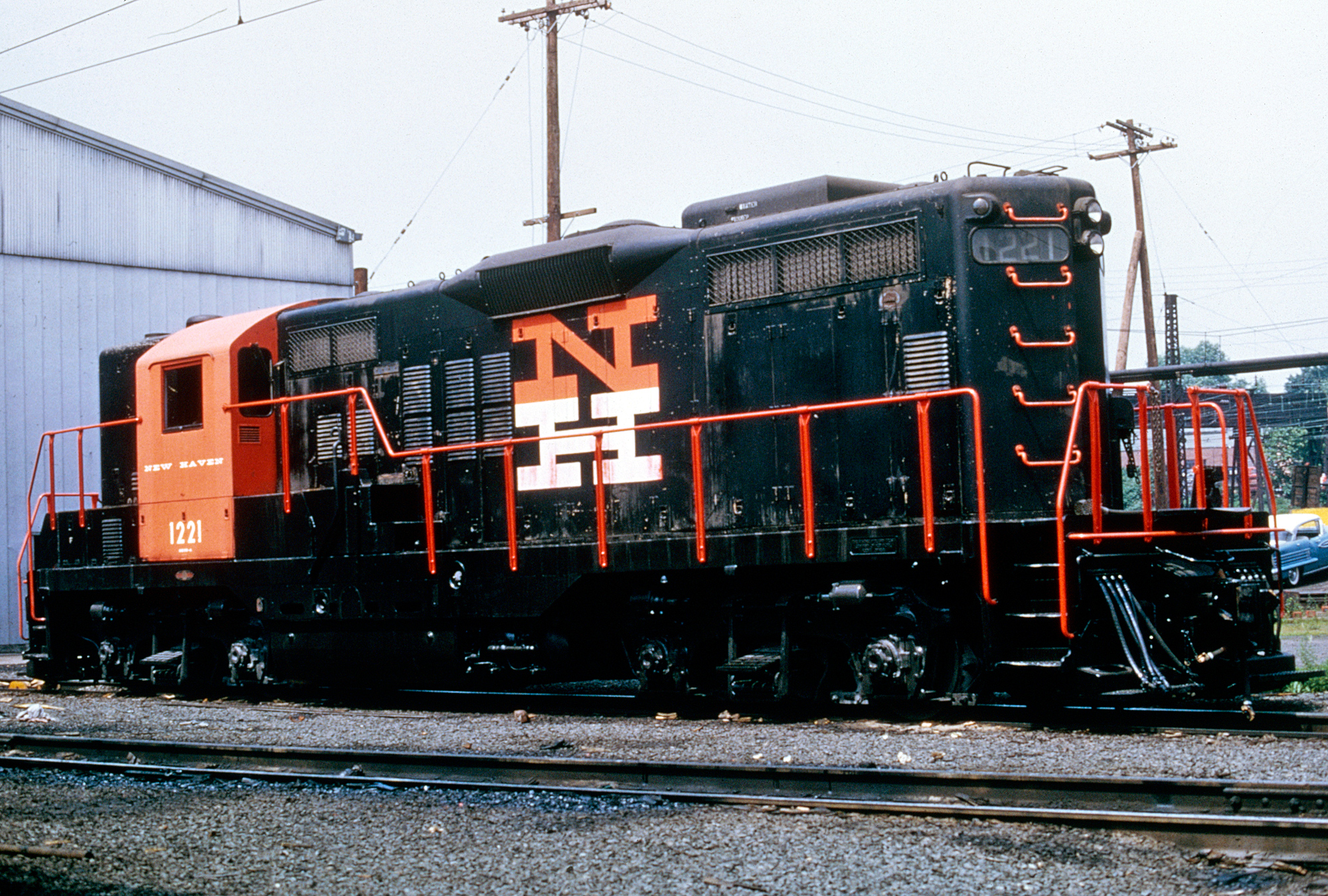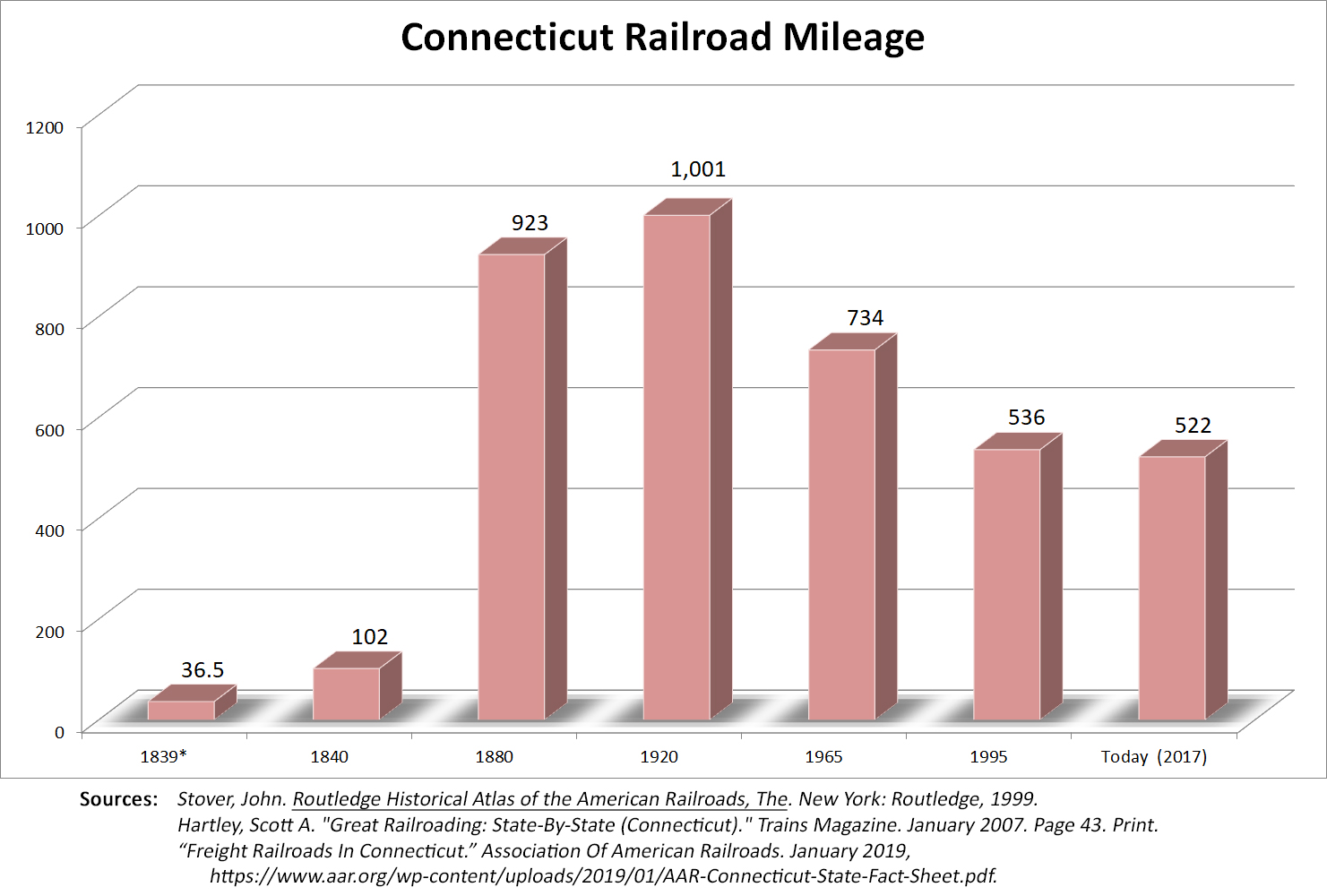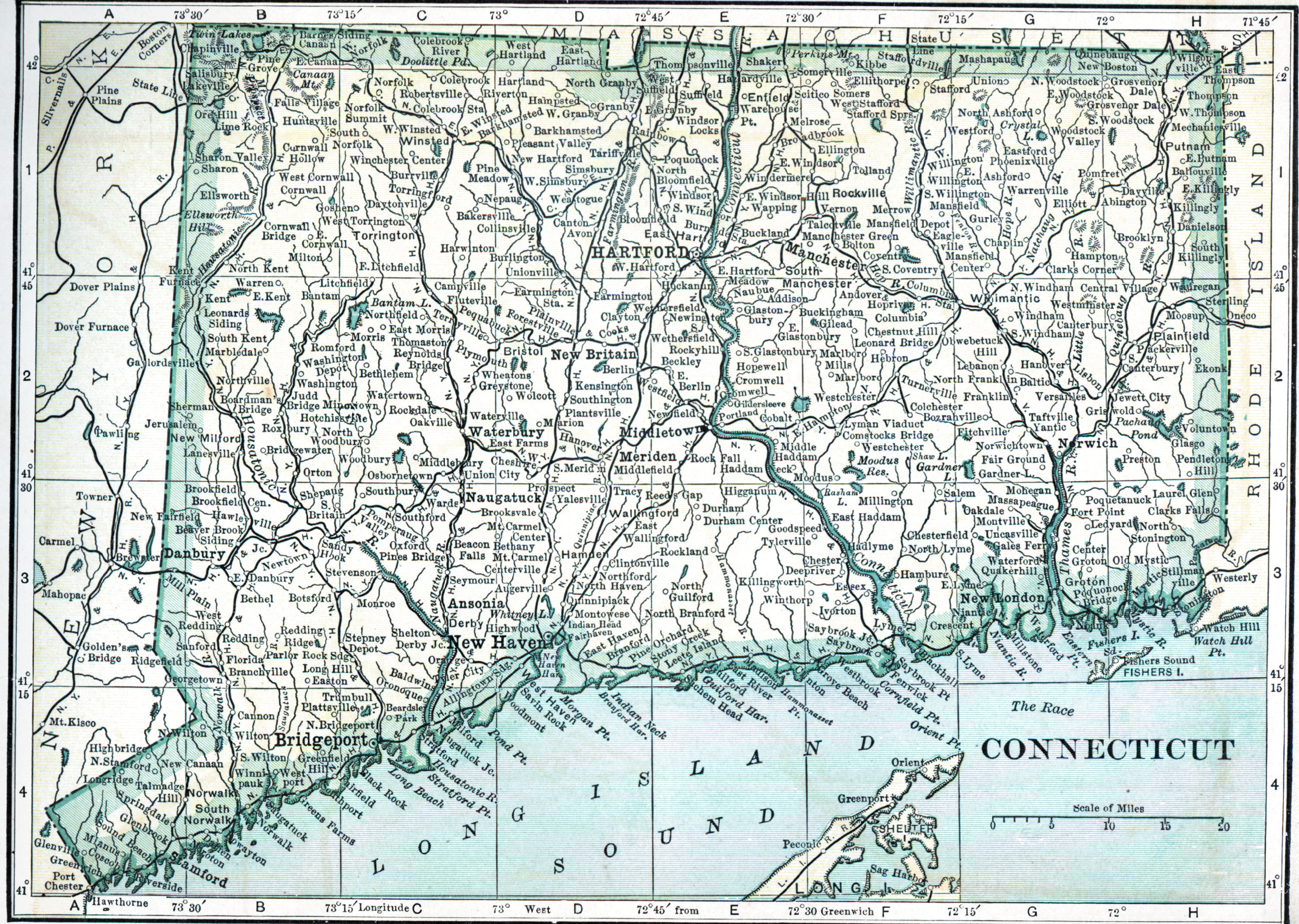Connecticut Railroads: Map, History, Abandoned Lines
Last revised: September 7, 2024
By: Adam Burns
Connecticut railroads have been established since the industry's infancy
during the first half of the 19th century. While the Constitution
State
has never had many miles of railroad it has held its importance in the
Northeastern rail system throughout the years.
For instance, its most prominent railroad was the New York, New Have & Hartford, commonly known as simply the New Haven. The company stretched throughout the state and provided commuters an important mode of transportation heading to either New York City or Boston.
History
The railroad also operated most of the state's rail lines until the Penn Central merger of 1969. In addition to its key Boston-New York route to the south, the New Haven operated numerous secondary corridors into the northern interior.
Many of these have since been abandoned leaving Connecticut with about half of its all-time rail infrastructure still in service.
Today, Connecticut is best known for being home to numerous passenger trains, notably Amtrak's Northeast Corridor (ex-New Haven).
In addition, the state is served by Metro-North and Shore Line East commuter train services, which play important roles in keeping the public on the move (many of these lines trace their roots back to the NYNH&H).
Photos
 New Haven GP9 #1221 lays over in New Haven, Connecticut during the 1960s. The New Haven was not a large buyer of EMD products but did acquire thirty GP9's along with some SW1200's and the classic FL9. American-Rails.com collection.
New Haven GP9 #1221 lays over in New Haven, Connecticut during the 1960s. The New Haven was not a large buyer of EMD products but did acquire thirty GP9's along with some SW1200's and the classic FL9. American-Rails.com collection.Connecticut railroads have their beginning in 1838 when the Hartford & New Haven completed its line between Meriden and New Haven, a distance of about 20 miles (the H&NH had originally been chartered in 1833 although funding shortfalls caused the completion of the line to be delayed).
The H&NH would go on to merge with the New York & New Haven in 1872 to form the now classic New York, New Haven & Hartford system.
While other railroads had trackage through Connecticut, notably the Central Vermont Railway none had quite the presence of the New Haven, which had a virtual monopoly (interestingly, a number of classic New England railroads did own lines that came close to entering the state).
The CV system had a history that dated back to around 1845 when the Vermont Central Railroad was chartered to connect Burlington, Vermont with Windsor, Connecticut.
The railroad had completed the line by 1849 and by 1873 had changed its name to the Central Vermont Railroad as it continued to grow (a few years earlier it also gained control of the Rutland Railway).
Statistics
Bankruptcies in the late 19th century eventually allowed the railroad to be purchased as it was taken over by the Grand Trunk Railway in 1898 (that same year when the CV emerged from bankruptcy it was renamed as the Central Vermont Railway), a system that became part of the Canadian National Railway in 1923.
Overall, the CV operated a system that stretched from New London, Connecticut to Brattleboro, Vermont where it used Boston & Maine trackage rights to Windsor, New Hampshire.
Abandoned Lines
Connecticut was an earlier pioneer of railroad technology, boasting its first in 1839. New England was a staunch proponent of the iron horse with many states launching their first around this time.
Despite its small size, Connecticut featured numerous railroads by the mid-19th century. Most wound up as part of the expansive New York, New Haven & Hartford Railroad.
These include names like the:
- Hartford & New Haven Railroad
- Shore Line Railway/New Haven & New London
- New York & New Haven Railroad
- New York & Boston Railroad/Boston & New York-Air Line Railroad
- New Haven, Middletown & Willimantic Railroad
- New Haven & Northampton
- New York & New England (the NY&NE was formed through many of the above-mentioned lines)
- New York, Providence & Boston
- Naugatuck Railroad
- Housatonic Railroad
Today, most of the abandoned rail lines you can explore are former New Haven lines albeit most were originally built by the one of the above-mentioned railroads.
While a great deal of the old New Haven is now gone across Connecticut, one particularly noteworthy route since removed is the old Boston & New York Air-Line/New York & New England from Middletown through southern Massachusetts.
This line was provide the NY&NH with an inside gateway between Boston and New Haven via central Connecticut. Unfortunately, it was slower than the Shore Line main line with stiffer grades and sharper curves resulting in its abandonment in sections over the years.
From there the CV continued on northward to Cantic, Quebec and a connection with the CN.
As for the CV's operations in Connecticut, its main line between Stafford (MP 71.4) and New London (MP 121.1) covered exactly 49.7 miles according to the railroad's timetable. The railroad also operated two branches reaching Palmertown and Fitchville.
State Mileage Chart
First Railroad
* The iron horse found its way to Connecticut in 1839 when the Hartford & New Haven (initially chartered in 1833) opened its first 36.5 miles between its namesake cities in 1839. The system went on to form part of the modern New York, New Haven & Hartford (New Haven).
At one time, when the Northeast was a bustling heavy industrial center, Connecticut boasted over 1,000 mile of trackage.
Today, that has been cut to just a third of the state's peak mileage at just over 330 miles.
State Map
Interestingly, while the New Haven disappeared into the Penn Central debacle, and later Conrail, much of its trackage in Connecticut remains and its importance is growing as passenger and commuter trains are becoming an ever-more attractive transportation option.
Today, the original New Haven main line is part of Amtrak's Northeast Corridor between Boston and Washington, D.C. For a more in-depth look at Connecticut's rail mileage over the years please refer to the table below, which highlights the state's network from its earliest days through the present.
Current Railroads
- CSX
- Providence & Worcester
- Connecticut Southern
- Branford Steam Railroad
- Central New England Railroad
- Naugatuck Railroad
- New England Central Railroad
- Housatonic Railroad
Passenger Rail Service
As for passenger and commuter trains outside of Amtrak, this has fallen mostly onto the shoulders of the State of Connecticut, which is another one of the top states in promoting the service.
Its services include that of Metro-North (which honors its rail heritage and has painted several locomotives in a New Haven inspired livery) and Shore Line East (which parallels I-95 and gives commuters another option over driving).
Aside from the state's passenger and freight rail network it also is home to several railroad museums.
These include the Connecticut Antique Machinery Association, Connecticut Eastern Railroad Museum, Connecticut Trolley Museum, Danbury Railway Museum, Essex Steam Train, Naugatuck Railroad, Shore Line Trolley Museum, and SoNo Switch Tower Museum.
Recent Articles
-
Pennsylvania Dinner Train Rides In Boyertown!
Jan 06, 26 06:48 PM
With beautifully restored vintage equipment, carefully curated menus, and theatrical storytelling woven into each trip, the Colebrookdale Railroad offers far more than a simple meal on rails. -
North Carolina ~ Murder Mystery ~ Dinner Train Ride
Jan 06, 26 11:26 AM
While there are currently no murder mystery dinner trains in the Tarheel State the Burgaw Depot does host a murder mystery dinner experience in September! -
Florida's - Murder Mystery - Dinner Train Rides
Jan 06, 26 11:23 AM
Florida, known for its vibrant culture, dazzling beaches, and thrilling theme parks, also offers a unique blend of mystery and fine dining aboard its murder mystery dinner trains. -
New Mexico's - Wine Tasting - Train Rides
Jan 06, 26 11:19 AM
For oenophiles and adventure seekers alike, wine tasting train rides in New Mexico provide a unique opportunity to explore the region's vineyards in comfort and style. -
Ohio's - Wine Tasting - Train Rides
Jan 06, 26 11:14 AM
Among the intriguing ways to experience Ohio's splendor is aboard the wine tasting trains that journey through some of Ohio's most picturesque vineyards and wineries. -
Connecticut's Thomas The Train Rides
Jan 06, 26 11:06 AM
For 2026, the tour stop at Essex brings Thomas (and Percy, too) to the historic Valley Railroad for a full day of events for the kids. -
Maryland's Thomas The Train Rides
Jan 06, 26 11:00 AM
In 2026, the B&O Railroad Museum in Baltimore welcomes the Let’s Rock, Let’s Roll Tour with four event days that combine a Thomas-themed excursion with other activities. -
Tennessee's Thomas The Train Rides
Jan 06, 26 10:51 AM
Set on the grounds of one of the Southeast’s best-known operating railroad museums, the Thomas the train event blends kid-friendly fun with the unmistakable sights, sounds, and atmosphere of a real wo… -
Georgia's Thomas The Train Rides
Jan 06, 26 10:44 AM
Day Out With Thomas is set to roll back into Cordele in 2026, bringing Thomas the Tank Engine and a full family festival to the SAM Shortline at Georgia Veterans Memorial State Park. -
Staten Island Rapid Transit
Jan 06, 26 10:02 AM
The Staten Island Rapid Transit has long served Staten Island since the 19th century and today is known as the Staten Island Railway. -
New York Dinner Train Rides In The Adirondacks!
Jan 05, 26 09:45 PM
Operating over a restored segment of the former New York Central’s Adirondack Division, the Adirondack Railroad has steadily rebuilt both track and public interest in passenger rail across the region. -
Ohio Dinner Train Rides On The CVSR!
Jan 05, 26 08:32 PM
While the railroad is well known for daytime sightseeing and seasonal events, one of its most memorable offerings is its evening dining program—an experience that blends vintage passenger-car ambience… -
Pennsylvania's - Wine Tasting - Train Rides
Jan 05, 26 01:08 PM
Wine tasting trains are a unique and enchanting way to explore the state’s burgeoning wine scene while enjoying a leisurely ride through picturesque landscapes. -
West Virginia - Wine Tasting - Train Rides
Jan 05, 26 01:02 PM
West Virginia, often celebrated for its breathtaking landscapes and rich history, offers visitors a unique way to explore its rolling hills and picturesque vineyards: wine tasting trains. -
Virginia - Wine Tasting - Train Rides
Jan 05, 26 12:58 PM
Wine tasting trains in Virginia provide just that—a unique experience that marries the romance of rail travel with the sensory delights of wine exploration. -
Utah - Wine Tasting - Train Rides
Jan 05, 26 12:37 PM
Utah, a state widely celebrated for its breathtaking natural beauty and dramatic landscapes, is also gaining recognition for an unexpected yet delightful experience: wine tasting trains. -
Kentucky Valentine's Train Rides
Jan 05, 26 12:31 PM
If you’re looking for a date night that feels a little more cinematic than the usual reservation-and-a-movie routine, Bardstown’s My Old Kentucky Dinner Train delivers the kind of evening you remember… -
Pennsylvania Valentine's Train Rides
Jan 05, 26 12:12 PM
Tucked amid the rolling farmland of Lancaster County, Pennsylvania, the Strasburg Rail Road stands as one of the most celebrated and successful heritage railroads in North America. -
New York's - Murder Mystery - Dinner Train Rides
Jan 05, 26 11:01 AM
New York State, renowned for its vibrant cities and verdant countryside, offers a plethora of activities for locals and tourists alike, including murder mystery train rides! -
Pennsylvania's - Murder Mystery - Dinner Train Rides
Jan 05, 26 10:37 AM
Pennsylvania, steeped in history and industrial heritage, offers a prime setting for a unique blend of dining and drama: the murder mystery dinner train ride.






















